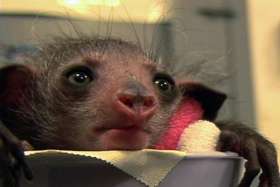Second Rare Aye-Aye Born at Duke Lemur Center

(PhysOrg.com) -- Ardrey and Merlin, rare, nocturnal aye-ayes from Madagascar, are pleased to announce the birth of their second child, a male, early on July 23 at the Duke Lemur Center.
Ichabod weighed 116 grams at birth, and has greenish-yellow eyes, black and gray hair, and extraordinarily large ears.
Head primate technician Samantha Trull, who cares for the aye-ayes daily, said the newest addition is one of the most vocal aye-ayes she has ever heard.
He is the second captive-bred baby for the couple, and only the third aye-aye born to captive-bred parents. Aye-ayes (EYE-EYEs) are critically endangered in their native island of Madagascar. The animals are kept at the Duke Lemur Center in Durham for conservation and research.
Aye-ayes use their bat-like ears and finger tapping to detect grubs hidden beneath tree bark. They can use beaver-like teeth to gnaw into the wood to expose the grubs or fish them out with spidery fingers ending in hooked nails.
Today, aye-ayes are extremely rare even on Madagascar both because of deforestation and because local superstition holds that if an aye-aye points a finger at a person, that person is doomed. The gentle animals are sometimes killed on sight.
The Lemur Center brought aye-ayes into captivity more than two decades ago and was the site of the first captive aye-aye birth -- Blue Devil, born in 1993.
Before the birth of this latest male and his older sister, all aye-ayes at the center had been born of fathers socialized in the wild, where they apparently learned the art of mating.
Ichabod's father, Merlin, had to be coached patiently by Lemur Center assistant director Dean Gibson for more than two years before he got the hang of mating. Although captive born herself, Ardrey had learned her role by breeding with a wild male.
“Merlin was scared to death of her, didn’t know what to do,” Gibson said. Instead of sniffing and mating as he was supposed to, Merlin would sniff and run away, apparently unsure what to do next. Ardrey would take annoyed swipes at the reluctant suitor.
“It took two years of catching her in her breeding cycle, putting Merlin with her every day during her cycle, coaching him along and stopping her from being aggressive toward him,” Gibson recalled. “I’d stand there with a net and defend him, and when he was doing well, give him nuts."
“Also, I’d give her treats to calm her down so she’d sit there and eat, rather than attack him,” she said. Eventually, Gibson’s coaching was successful, and the animals bred. In 2006, a female named Angelique was the result.
The experience with the aye-ayes has taught the center’s primatologists an invaluable lesson -- that the complex creatures need socialization to mate, Gibson said.
According to center director Anne Yoder, the animals’ need for socialization is driving design of planned new housing at the center.
”We need to build facilities so that these animals can live in the social structure required for their natural reproductive behaviors to emerge and continue,” Yoder said. “Otherwise, we might find ourselves housing the last aye-aye, or the last examples of other endangered lemurs.”
Video: www.duke.edu/today/archive/oncamera.php?id=20455
Provided by Duke University

















